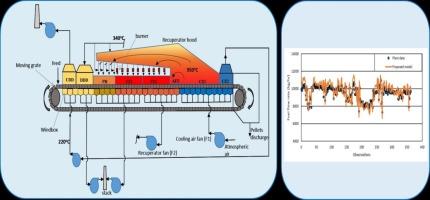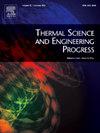在工业直篦机系统中制定铁矿球团压实工艺:实时实验和验证
IF 5.1
3区 工程技术
Q2 ENERGY & FUELS
引用次数: 0
摘要
了解铁矿石球团的复杂熟化过程对于炼钢行业的直篦机系统至关重要。迄今为止,还没有人尝试在考虑到物理化学过程(干燥、碳燃烧和石灰石煅烧)以及球团内部和热气与球团之间的热量传递的情况下,对该装置的行为进行预测。此外,所报告的模型主要是通过锅试验数据进行验证的。为了弥补这些研究空白,本文提出了一个工业压煮装置的严格模型框架,其中考虑到了上述所有问题以及其他一些实际问题,包括热气到炉排条的传热以及系统漏气造成的热损失。为了验证这一严谨的计算方法,我们进一步尝试使用配备热车的压痕系统进行实时实验。实验结果首次表明,预测的颗粒、篦条和运行床出口气体的温度曲线与工厂数据一致。为研究拟议配方在不同运行条件下的性能,还进一步获得了燃料消耗数据。据观察,测量燃料消耗率和预测燃料消耗率之间的平均绝对百分比误差(MAPE)相当低(即 4.2%)。因此,建议将拟议配方用于在线特性预测、工艺设计、优化、故障诊断、控制和扩大压 缩装置的规模。本文章由计算机程序翻译,如有差异,请以英文原文为准。

Formulating iron ore pellet induration process in an industrial straight grate system: Real-time experimentation and validation
Understanding the complex process of iron ore pellet induration is crucial in a straight grate system in the steelmaking industry. There is no attempt made so far to predict the behavior of this unit considering the physiochemical processes (drying, carbon combustion and limestone calcination) along with the heat transfer within the pellet, and between the hot gas and pellet. Moreover, the reported models are validated mainly with the pot test data. To address these research gaps, in this contribution, a rigorous model framework is proposed for an industrial induration unit considering all these above-mentioned issues together with some other practical aspects, including the heat transfer from hot gas to grate bar and heat loss due to air leakage into the system. To validate this rigorous formulation, attempt is further made to perform the real-time experimentation with induration system equipped with a thermocar. It is shown first time that the predicted temperature profiles of the pellets, grate bar and exit gas associated with the running bed are consistent with the plant data. The fuel consumption data is further obtained to investigate the performance of the proposed formulation at different operating regimes. It is observed that the mean absolute percentage error (MAPE) between the measured and predicted fuel rates is reasonably low (i.e., 4.2%). With this, it is recommended to use the proposed formulation for online property prediction, process design, optimization, troubleshooting, control and scale-up of the induration unit.
求助全文
通过发布文献求助,成功后即可免费获取论文全文。
去求助
来源期刊

Thermal Science and Engineering Progress
Chemical Engineering-Fluid Flow and Transfer Processes
CiteScore
7.20
自引率
10.40%
发文量
327
审稿时长
41 days
期刊介绍:
Thermal Science and Engineering Progress (TSEP) publishes original, high-quality research articles that span activities ranging from fundamental scientific research and discussion of the more controversial thermodynamic theories, to developments in thermal engineering that are in many instances examples of the way scientists and engineers are addressing the challenges facing a growing population – smart cities and global warming – maximising thermodynamic efficiencies and minimising all heat losses. It is intended that these will be of current relevance and interest to industry, academia and other practitioners. It is evident that many specialised journals in thermal and, to some extent, in fluid disciplines tend to focus on topics that can be classified as fundamental in nature, or are ‘applied’ and near-market. Thermal Science and Engineering Progress will bridge the gap between these two areas, allowing authors to make an easy choice, should they or a journal editor feel that their papers are ‘out of scope’ when considering other journals. The range of topics covered by Thermal Science and Engineering Progress addresses the rapid rate of development being made in thermal transfer processes as they affect traditional fields, and important growth in the topical research areas of aerospace, thermal biological and medical systems, electronics and nano-technologies, renewable energy systems, food production (including agriculture), and the need to minimise man-made thermal impacts on climate change. Review articles on appropriate topics for TSEP are encouraged, although until TSEP is fully established, these will be limited in number. Before submitting such articles, please contact one of the Editors, or a member of the Editorial Advisory Board with an outline of your proposal and your expertise in the area of your review.
 求助内容:
求助内容: 应助结果提醒方式:
应助结果提醒方式:


